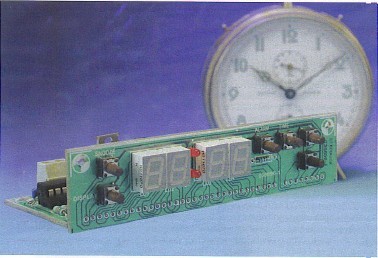

Project Solutions
Digital Alarm Clock——Based on a PIC micro (1)
Published:2011/7/22 0:55:00 Author:Li xiao na From:SeekIC
by M. Conde de Almeida
Although digital alarm clocks have been around for years, most of today’s off the shelf products suffer from serious design limitations. For example, many don’t keep track of weekdays and can only store one alarm time. High time for a home-brew design that does a better job. 
Off the shelf alarm clocks present a serious limitation if, for instance, you and your partner have different wake-up times or if you have to give or take medication at regular intervals. This limitation gets more serious if you want alarms to go off only on specific days of the week or only during work days. The time setting process on most clocks is also subject to improvement. In the majority of cases you adjust time by incrementing minutes and hours. If your clock is at, say, 06:15h and the correct time is 20:58h you need to keep a key pressed for quite some time and release it well before the desired hour/minute, switching to ’slow’ setting. If not, you’re past the desired time and have to start all over again.
This article proposes a solution for these design weaknesses by discussing a low-cost circuit based on the popular PIC 16F84A microcontroller from Microchip.
Our digital alarm clock keeps track of weekdays and has eight alarms that can be individually set to go off every day, only on working days or, if you want, on a specific day of the week.
The time setting process allows the adjustment of each digit of the clock separately by means of Up and Down (+ and -) keys. It also incorporates some other interesting features.
Like all good digital alarm clocks our project has a battery that keeps the clock ticking in the event of an AC power failure. In battery-powered mode the display is turned off to reduce energy consumption. However, if you want to check the time you may still enable the display by pressing a ’display on’ button. In battery mode the alarms will continue to operate normally. When an alarm goes off the display will be turned on to show the current time.
The eight different alarm times are kept in the PIC’s EEPROM. So, you won’t have to adjust any of the alarms again even if the battery fails. A ’snooze’ key will temporarily turn an alarm off. The alarm will be triggered again after a minute until it is definitely turned off. A master Alarm On/Off key will enable/disable all the alarms, independent of their individually set states. A bright LED display makes it easy to check the time from a distance or in the dark.
The 4-MHz crystal oscillator guarantees a pretty accurate time base for the clock (error = 0.000427%).
Reprinted Url Of This Article: http://www.seekic.com/blog/project_solutions/2011/07/22/Digital_Alarm_Clock——Based_on_a_PIC_micro_(1).html
Print this Page | Comments | Reading(1281)
Article Categories
New published articles
· Imagination works with TSMC to develop FinFET process
Author:Ecco Reading(30202)
· XMOS pushes event-driven MCUs with lower price
Author:Ecco Reading(3462)
· Intel brings upgraded 32-nm SoC for smartphones
Author:Ecco Reading(3182)
· Micron pushes TLC 128-Gbit NAND flash
Author:Ecco Reading(3662)
· Intel will stop supplying desktop motherboards
Author:Ecco Reading(5233)
· Processor market was expected to regain strength in 2013
Author:Ecco Reading(3249)
· It was reported that TSMC sales fall steeply
Author:Ecco Reading(3390)
· Cisco, NXP work with auto wireless startup
Author:Ecco Reading(3531)
· Micron was impacted by manufacturing glitch
Author:Ecco Reading(3936)
· China can make 22-nm transistor by themselves
Author:Ecco Reading(3708)
· Chip market rebound is coming, according to survey
Author:Ecco Reading(3678)
· Sony, Toshiba will spend more on chips, iSuppli reports
Author:Ecco Reading(3715)
· Qualcomm becomes the 13th company to join NFC Forum board
Author:Ecco Reading(6029)
· TSMC increases building work for FinFET fab
Author:Ecco Reading(3693)
· TI plans to cut 1,700 jobs in OMAP shift
Author:Ecco Reading(4479)